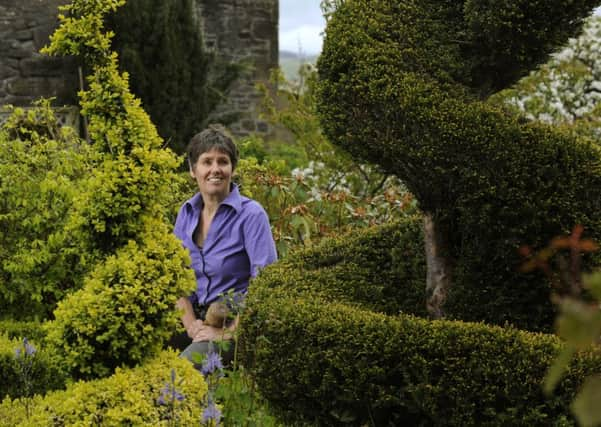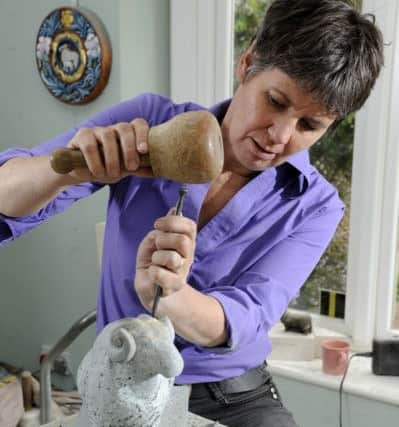Ewe goes there?


Just look at their sculpture. There are the rippling muscles and explosive athleticism of discus and spear throwers at the point of release. There’s the serene gaze and grace of the Venus de Milo. And everywhere there’s the physical perfection of elegantly coiffed gods and emperors, the body beautiful permanently frozen in stone. Haughty, straining chariot horses might make their way on to the plinth – but not sheep. Until now.
In a quiet part of North Yorkshire sculptor Fiona Bowley is putting the humble Swaledale, Herdwick and Wensleydale longwool on the pedestal.
Advertisement
Hide AdAdvertisement
Hide AdCreated using carving techniques perfected by ancient Assyrian, Greek, Roman and medieval artists, these commonplace animals now stand proud, regally looking out over the landscape of rolling hillsides and green fields that they have helped to create.


“When you look at the work of previous civilisations throughout history, it’s usual to feature kings, emperors or heroes of legend,” she says. “I admire and enjoy carving in that style but I’m inspired by that which surrounds me.
“I’m quite conscious that sheep mean different things to different people and my background is as a townie. I don’t think of them as cute and cuddly but I do see them as something that has connected us to the landscape for a long time. We have a relationship with them and I feel it more emotionally than theoretically.”
Despite rarely entering her sculptures in exhibitions, there was an opportunity to view some of her more recent work at the North Yorkshire Open Studios events that have just taken place. Visitors to her home at Thornton-in-Craven saw the culmination of a concept she has been working on since 1987. Dotted around the studio and terrace is a small flock of stately stone sheep, the textures and patterns of their fleeces reminiscent of the hair and beards of gods and rulers in ancient statues.
Advertisement
Hide AdAdvertisement
Hide AdSome of Fiona’s inspiration is drawn from as far back as the Assyrian civilisation, which dominated great swathes of the Middle East in the first millennium BC. Friezes recovered from the capital at Nineveh show intricate war and hunting scenes involving lions, horses and dogs.
“The Assyrians were awesome in their technical ability but they were very much shallow relief carvers,” says Fiona. “I admire the amount of extra light and shade they could create in just millimetres of depth but I’m applying that to a three-dimensional object.”
This ancient craftsmanship was the starting point for a sculpture of a fiercely protective ewe suckling her lamb in dark grey serpentine stone, her fleece modelled on the coat of an Assyrian lion from the sixth century BC. A plucky little Swaledale sheep perched on its pedestal pays homage to the great Greek sculptor Polykleitos, one of the founding fathers of classical sculpture. Nearby a pair of Wensleydale longwools stare down their noses imperiously. Historical inspiration is found elsewhere in her work, with a Portland stone bowl carved with patterns from an Assyrian carpet.
But it’s not just the sculptures that hark back to previous eras. Fiona relies on no modern machinery to make her work easier– just traditional round-headed mallets, hammers and chisels. “I’ve always used hand tools,’ she says. “There’s no dust and no noise – I just have to be fast and accurate.”
Advertisement
Hide AdAdvertisement
Hide AdAfter studying Fine Art in Leeds, Fiona’s first job came as a baptism of fire. Following an unusual career path by training as a stonemason. Restoring the medieval bases to the buildings at Carlisle Court involved eight-hour shifts of hard, physical labour in freezing temperatures at the age of just 22. “It was so cold that you needed to keep working and I was very strong and fit,” she says. The long days left her so exhausted that she was often unable to prevent herself hitting her hands with the heavy hammers, probably fracturing many small bones in the process.
Three years later she was back in Yorkshire and one of a team of masons and carvers tasked with restoring York Minster after fire had ripped through the south transept in1984, causing £2.25m of damage. Working on the roof bosses may have involved some scrambling up and down turrets and along scaffolding but at least there was the luxury of being based in a warm workshop for most of the time. Yet there were new technical challenges to overcome, adapting to the finely grained, denser magnesian limestone of the minster stonework after the softer red sandstone of Carlisle and learning to carve in wood.
“It was a very creative time for me and I gained a lot of discipline,” she says. “I learned not to take myself seriously and approach the work as a tradesperson or craftsperson, not as an artist. There was huge emphasis on productivity but what organisation can genuinely afford to have people sitting around contemplating? Pressure is very good if you have come from an art college background.
“What I loved about that time is that I was truly approaching the carving like medieval craftspeople because they would have been paid piecework. And the work was for the building, rather than personal glory.”
Advertisement
Hide AdAdvertisement
Hide AdDespite being one of a few women working in a predominantly male field, Fiona experienced little sexist behaviour. She puts this down to her ability to carry out all the physical tasks except heavy lifting and her willingness to ask for help with this. Any rivalry in the minster workshops was possibly between the masons and the carvers, who may have been resented for attracting greater media attention.
Following a period of freelance restoration work, Fiona resumed her artistic career when she was invited to work with a landscape architect on a project at Brierfield near Burnley. Yet even public arts commissions offered a link with the past, through learning history and stories from local residents and following the medieval tradition of carving them in stone. But the emphasis on decision making by committee, which can inhibit the creative process, means that Fiona now produces mainly individual pieces for private commissions.
One rare exception was the recent siting of a sheep carved in a boulder outside the Yorkshire Dales National Park Authority car park in Malham. Because the piece was so heavy, the gilt lettering had to be completed in situ on a windy day, with expensive palladium leaf floating away on the breeze. Elsewhere you can see her work at St Peter’s in Addingham, where three panels are based on a translation of the Venerable Bede’s “death song” in recognition of the remains of the Anglo-Saxon Christian community discovered during construction of a new village hall. She also uses her love of storytelling to carve striking gravestones, sometimes incorporating imagery from the natural world, which allow the bereaved to express their personal feelings about deceased relatives. Monuments are inscribed with Roman lettering modelled on the carving on Trajan’s Column.
Students come away from her workshops having mastered basic stone carving skills and even produce a head in the style of a medieval cathedral carving.
Advertisement
Hide AdAdvertisement
Hide AdSo how long does it really take to make a sheep semi-divine? You could say it’s the three decades that Fiona has been working on the concept. Maybe it’s the six millennia since Polykleitos revolutionised the art world with his new approach to sculpture. Or perhaps you need to go back even further to one of the world’s first great civilisations, when the ancient Assyrians chose wonderfully carved reliefs of noble creatures to glorify their magnificent capital of Nineveh.
• For more information visit www.fionabowley.com call 01282 843631 or email [email protected].